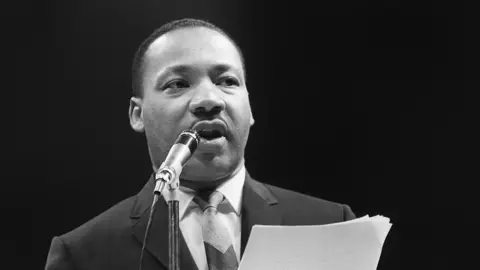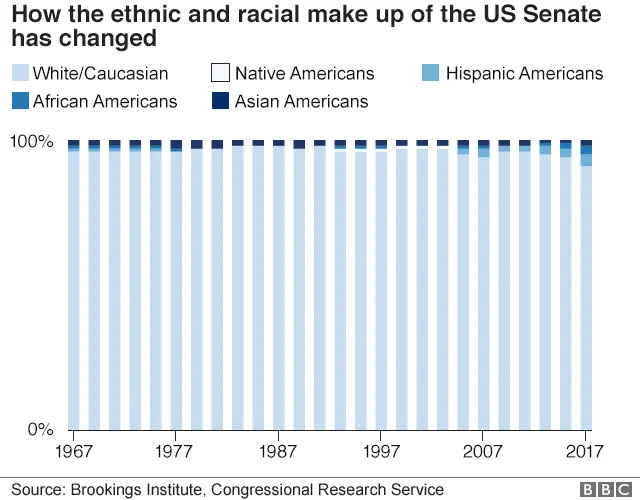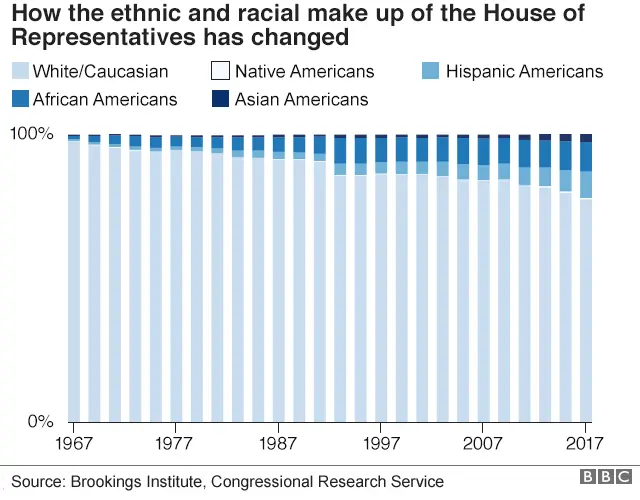Martin Luther King: Are there too many white politicians?
 AFP
AFPThe civil rights leader Martin Luther King Jr, in a 1957 speech at the Lincoln Memorial in Washington DC, called on Congress to introduce equal voting rights for all Americans.
"Give us the ballot," said Dr King, "and we will fill our legislative halls with men of goodwill".
Half a century after his death, Reality Check looks at how the racial and ethnic make-up of Congress and state legislatures has changed.
The US Congress is made up of 435 elected lawmakers in the House of Representatives, the lower chamber, and 100 in the Senate, the upper chamber.
US politics has gradually become more diverse and this Congress is the most racially and ethnically diverse yet. Barack Obama's rise to the presidency was also seen as an important milestone.
But compared to the population as a whole, many branches of political office in America are still disproportionally white.

Changes in the Senate
Months before Dr King was killed, Edward Brooke became the first African American to win election to the Senate by a popular vote.
Mr Brooke, who represented Massachusetts and served two full terms, was known for his work in promoting low-income housing, and racial equality in the South.
Seven African-American senators have served since then, two of them women.
In Congress as a whole, the number of African-, Hispanic- and Asian-American citizens has steadily increased in the last few decades. But lawmakers are still overwhelmingly white.
In the last half a century, the total minority population in the US has more than doubled.
But while about one fifth of the most recent Congress was from a minority group, minorities represent about 38% of the population overall.
In 2017, 3% of the Senate and 10% of the House of Representatives was African American - but that group represents about 13% of the population overall.
There were similar proportions for Asian Americans (2% in the Senate, 3% in the House, but 6% overall) and Hispanic Americans (4% in the Senate, 9% in the House, but 18% overall) in Congress.

What about the House of Representatives?
About 23% of the House come from a minority background, a higher proportion than in the Senate.
Out of the number of new Congressmen and women, 34% were from a minority group, according to Pew Research Centre. This much more closely resembles an increasingly diverse country.
Almost all of the members of the House of Representatives from a minority group are in the Democratic party. The process of making politics more representative has been far less substantial among Republicans, says Jennifer Lawless, director of the Women and Politics group at American University in Washington DC.
One of the reasons why it matters, says Ms Lawless, is because politicians are more likely to raise issues affecting a minority group if they have been affected by the issue themselves as a member of that group.
There are two Native Americans serving in the House of Representatives: Tom Cole, of the Chickasaw tribe, represents Oklahoma, and Markwayne Mullin, of the Cherokee tribe, also represents Oklahoma.
There have been three senators of known Native American descent. Ben Nighthorse Campbell, a member of the North Cheyenne tribe, served until 2005. A record number of Native Americans ran for office in 2016.

State politics
More than 7,000 men and women are elected to serve in state legislatures. Like their counterparts in the national Congress, state lawmakers are less diverse than the whole population. Based on a study by the National Conference of State Legislatures (NCSL) in 2015, Hawaii, followed by New Mexico, have the highest proportion of minority lawmakers in their state - 78% and 49% respectively. The state with the highest percentage of white lawmakers in 2015 was North Dakota with 99%. Minorities account for about 15% of the state's total population.
Hawaii, California, the southern states on the Mexican border, Florida and some of the states along the eastern coast have the highest proportion of legislators from minority populations. States in the middle of the country and those on the northern border generally have the lowest percentage.
The state with the highest proportion of African-American legislators is Mississippi, Hawaii has the highest proportion of Asian and Pacific Islanders, for Native Americans it's Montana and for Hispanic Americans it's New Mexico.
Trying to assess exactly how the situation has changed since the death of Dr King is challenging as there isn't complete data for each ethnic group going back to the 1960s. But the NCSL research did reveal that the percentage of African Americans elected at the state level rose from 2% to 9% between 1971 and 2011. Hispanic Americans represent 5% of state legislators - up from 2.2% in 1991 - but well below the 18% of the total population that Hispanic Americans account for.



